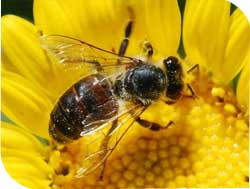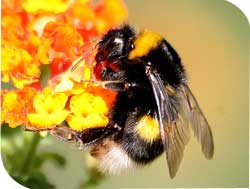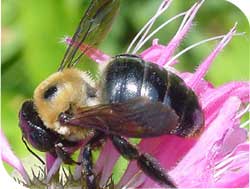
 Wasps and bees are beneficial insects, although they are generally considered to be pests because of
Wasps and bees are beneficial insects, although they are generally considered to be pests because of
their ability to sting
These insects are beneficial in their activities, particularly as
predators of pest insects and as pollinators.
 It is important to distinguish between these insects because different methods may be necessary to control
It is important to distinguish between these insects because different methods may be necessary to control
them if they become a nuisance:-
 Wasps appear smoothed-skinned and shiny
Wasps appear smoothed-skinned and shiny
 Bees are fuzzy and more robust in appearance
Bees are fuzzy and more robust in appearance
 Wasps are predators, feeding insects and other arthropods to their young
Wasps are predators, feeding insects and other arthropods to their young
 Bees feed on nectar and pollen from flowers
Bees feed on nectar and pollen from flowers
 Wasps build nests out of a papery material. Wasps may nest in the ground, in trees and shrubs,
Wasps build nests out of a papery material. Wasps may nest in the ground, in trees and shrubs,
under horizontal surfaces such as eaves, and in buildings where they occupy wall voids and similar spaces
Bees build combs made of wax
1. WASPS -::- YELLOWJACKETS

 Yellowjackets are banded yellow or orange and black and are commonly mistaken for honey bees, but they lack
Yellowjackets are banded yellow or orange and black and are commonly mistaken for honey bees, but they lack
the hairy body and are more intensely colored
 Yellowjackets typically nest underground using existing hollows. Occasionally nests can be found in dark,
Yellowjackets typically nest underground using existing hollows. Occasionally nests can be found in dark,
enclosed areas of a building, such as crawl spaces or wall voids
 Yellow jackets are excellent predators of potential pest insects
Yellow jackets are excellent predators of potential pest insects
 When temperatures cool in late summer, yellowjacket numbers peak just as their insect food supply
When temperatures cool in late summer, yellowjacket numbers peak just as their insect food supply
begins to decline.They scavenge more aggressively at this time, taking food from trash containers and picnickers
 When disturbed, yellowjackets can sting repeatedly; their stingers are not barbed nor lost after stinging like
When disturbed, yellowjackets can sting repeatedly; their stingers are not barbed nor lost after stinging like
those of honey bees
HORNETS

 The so-called bald-faced hornet about ¾-inch long, black and white, with white face, is actually
The so-called bald-faced hornet about ¾-inch long, black and white, with white face, is actually
a larger yellowjacket species
 Its nest is the familiar basketball-size papery oval hanging from tree limbs and sometimes structures
Its nest is the familiar basketball-size papery oval hanging from tree limbs and sometimes structures
 Nests occur in trees and in attics and wall voids of structures near forested areas
Nests occur in trees and in attics and wall voids of structures near forested areas
 Nests often attract attention because of their large size, but hornets rarely sting unless the
Nests often attract attention because of their large size, but hornets rarely sting unless the
colony is seriously disturbed
 Hornets feed their young live insects and do not share the scavenging habit of yellowjackets
Hornets feed their young live insects and do not share the scavenging habit of yellowjackets
 Baldfaced hornets are beneficial because they capture other insects
Baldfaced hornets are beneficial because they capture other insects
PAPER WASPS

 Paper wasps are about 0.7 to 1.0 inch long, slender and variously colored with brown, red and yellow
Paper wasps are about 0.7 to 1.0 inch long, slender and variously colored with brown, red and yellow
 They build their single-comb unprotected nest from the eaves or porches of buildings or other sheltered locations
They build their single-comb unprotected nest from the eaves or porches of buildings or other sheltered locations
 Paper wasps are beneficial predators of caterpillars and other insects and do not scavenge
Paper wasps are beneficial predators of caterpillars and other insects and do not scavenge
MUD DAUBERS

 Mud daubers vary in length from 0.5 to 1.25 inches and are very slender with threadlike waists
Mud daubers vary in length from 0.5 to 1.25 inches and are very slender with threadlike waists
 Mud dauber wasps are named for their habit of constructing tubular nests of mud plastered on
Mud dauber wasps are named for their habit of constructing tubular nests of mud plastered on
the exterior surfaces of structures
 Its nests are about 2 inches long
Its nests are about 2 inches long
 Mud daubers usually sting only when pinned against the skin
Mud daubers usually sting only when pinned against the skin
CICADA KILLERS

 The cicada killer wasp is 1.5 to 2.0 inches long, and is brownish black with yellow markings on
The cicada killer wasp is 1.5 to 2.0 inches long, and is brownish black with yellow markings on
the abdomen and face
 The female digs a burrow in the soil. It captures cicadas, paralyzing them by stinging, and places
The female digs a burrow in the soil. It captures cicadas, paralyzing them by stinging, and places
them in the burrow
 Inside it lays an egg on the cicada, then covers the burrow with soil
Inside it lays an egg on the cicada, then covers the burrow with soil
 Larvae consume the paralyzed cicada and emerge as adult wasps the following spring
Larvae consume the paralyzed cicada and emerge as adult wasps the following spring
 The only damage these wasps cause is the unsightly dirt piles dug out to create nests
The only damage these wasps cause is the unsightly dirt piles dug out to create nests
BEES - HONEY BEES

 Honey bees are about 0.5 inch long with a fuzzy light brown to black appearance, with striped brown
Honey bees are about 0.5 inch long with a fuzzy light brown to black appearance, with striped brown
and black abdomens
 They are considered to be the most beneficial species of insect because they pollinate plants and
They are considered to be the most beneficial species of insect because they pollinate plants and
produce honey and bee's wax
 Honey bees live in extra large colonies of up to 50,000 individuals
Honey bees live in extra large colonies of up to 50,000 individuals
 The nest consists of several tiers or combs made of beeswax. It is located in cavities of trees, rock
The nest consists of several tiers or combs made of beeswax. It is located in cavities of trees, rock
formations and buildings
 There is a lower risk of being stung around a swarm because it is a period of vulnerability and the colony has
There is a lower risk of being stung around a swarm because it is a period of vulnerability and the colony has
no hive or honey to protect
BUMBLE BEES

 Bumble bees are robust and densely covered with black and yellow hairs
Bumble bees are robust and densely covered with black and yellow hairs
 They range in size from about 0.5 to 1.0 inch long
They range in size from about 0.5 to 1.0 inch long
 Bumble bees inhabit nests in old rodent burrows, under porches and in wall voids
Bumble bees inhabit nests in old rodent burrows, under porches and in wall voids
 Bumble bees usually are not overly aggressive, but they will sting if molested
Bumble bees usually are not overly aggressive, but they will sting if molested
CARPENTER BEES

 Bumble bees are robust and densely covered with black and yellow hairs
Bumble bees are robust and densely covered with black and yellow hairs
 They range in size from about 0.5 to 1.0 inch long
They range in size from about 0.5 to 1.0 inch long
 Bumble bees inhabit nests in old rodent burrows, under porches and in wall voids
Bumble bees inhabit nests in old rodent burrows, under porches and in wall voids
 Bumble bees usually are not overly aggressive, but they will sting if molested
Bumble bees usually are not overly aggressive, but they will sting if molested